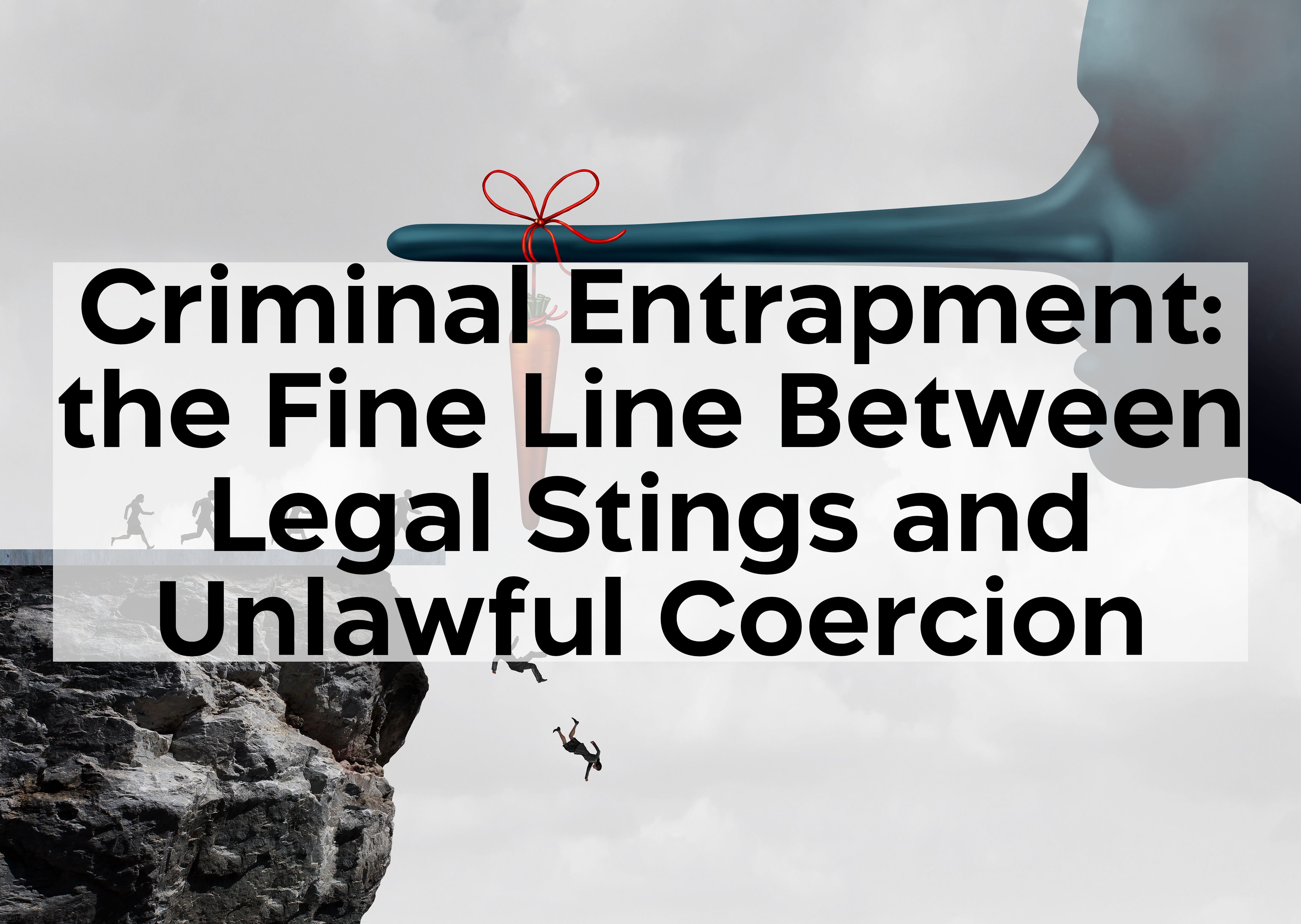Entrapment refers to the actions of a law enforcement official that persuade or encourage a person to engage in an illegal act that that person would otherwise have been unlikely to commit.
Entrapment is a legal defense and concept that comes into play when a law enforcement official instigates or lures a person to commit an unlawful act they would not ordinarily perform, thereby causing them to face criminal charges for that act. This typically occurs when an officer encourages or manipulates an individual’s decision-making process beyond merely providing an opportunity for them to commit the crime. However, the precise legal definition and acceptance of entrapment as a valid defense may vary between jurisdictions.
It is crucial to differentiate between legitimate law enforcement strategies, such as sting operations, and entrapment, which is considered an abuse of power and, thus, a violation of a person’s rights.
In cases where entrapment is successfully argued, it may result in the dismissal of charges or an acquittal.
ELEMENTS OF ENTRAPMENT
An individual who has been entrapped may initiate an action to invalidate their arrest on the grounds of entrapment, as in Mathews v. United States.1485 U.S. 58, 63 (1988). The Court held that a defendant who denies one or more of the elements of the crime is entitled to an entrapment instruction whenever there is sufficient evidence from which a reasonable jury could find entrapment. The Court rejected the government’s argument that a defendant should not be allowed to rely on inconsistent defenses, such as denying the offense while at the same time claiming entrapment for having committed the offense. For an individual to prevail in a suit for entrapment against law enforcement, two elements must be proven:
- Law enforcement officials induced the individual to commit the crime.
- The individual was not predisposed to commit the crime.
HISTORY OF ENTRAPMENT
The term entrapment was first recorded in the U.S. in an 1899 federal court case, People v. Braisted.213 Colo. App. 532 Pac 796 (1899). First recorded mention of “entrapment.” However, the doctrine of entrapment was not clearly defined until 1932 in Sorrells v. United States, when the U.S. Supreme Court ruled that entrapment was a valid defense that could be considered by the jury.3287 U.S. 435 (1932). The Court held that entrapment occurs when “the criminal design originates with the officials of the Government, and they implant in the mind of an innocent person the disposition to commit the alleged offense and induce its commission in order that they may prosecute.” The history of the doctrine of entrapment is complex and varies depending on the jurisdiction and the type of crime involved. In fact, in the case of Russell v. United States,4 411 U.S. 423 (1973). A significant case because it was the first in which entrapment was proven, but the conviction was upheld regardless. the first case where entrapment was proven, the conviction was still upheld. Some other historical examples of entrapment include the following:
- In the 18th and 19th centuries in England, the Bank of England and the Royal Mint used entrapment to catch people involved in currency crime during the Restriction Period of 1797–1820.
- In the 1920s and 1930s in the United States, New York City police used entrapment to arrest homosexual men for cruising in bars, streets, parks, and subway washrooms. This practice continued until 1966, when a coalition of homosexual activists, civil libertarians, café owners, and Bohemian writers persuaded Mayor John Lindsay to end it.
- In the United States in the 1970s and 1980s, the FBI used entrapment to infiltrate and disrupt radical political groups, such as the Black Panthers, the Weather Underground, and the American Indian Movement.
WHAT IS THE DIFFERENCE BETWEEN ENTRAPMENT AND A STING?
Some people liken entrapment to a sting, but these are two different things, with the difference lying in the intent and conduct of both the defendant and the law enforcement officer. In entrapment, which is illegal, the defendant must prove that they were not predisposed or willing to commit the crime and that the officer used inappropriate pressure, harassment, fraud, or threats to induce them to commit the crime. In a sting operation, the police officer does not induce or persuade the defendant to commit the crime but rather provides an opportunity for the defendant to act on his or her own criminal intent. If the defendant had a predisposition to commit a crime, he or she would have done so even without the officer’s involvement. Entrapment involves inducing someone through harassment or coercion into committing a crime that they would not have otherwise done so.
While both entrapment and sting operations involve law enforcement agencies and illegal activities, they are fundamentally different in nature. Entrapment is an unlawful practice where a law enforcement officer coerces or induces an individual into committing a crime that they would not have otherwise committed. The key element here is the instigation of criminal intent that was not previously present. For instance, an officer is not allowed to bait a law-abiding citizen into committing theft and then arrest them for it; this would be entrapment. Conversely, a sting operation is a strategic, legally sanctioned ploy where law enforcement officials impersonate criminals or facilitate criminal opportunities to catch persons predisposed to criminal behavior. The purpose of a sting is to expose and apprehend persons who are already engaged in or willing to engage in criminal activity. In a sting, the criminal intent originates from the perpetrator, not from law enforcement. For example, a law enforcement officer posing as a drug dealer to catch willing buyers is a sting operation, not entrapment, as the buyers have shown their predisposition towards criminal activity. Understanding this key distinction is critical when assessing the legality and ethics of law enforcement methods.
Entrapment is a legal defense to a criminal charge but can only be applied in certain cases.
HOW TO DETERMINE IF ENTRAPMENT HAS OCCURRED
There are two different tests to determine if entrapment has occurred: the subjective test and the objective test. The subjective test focuses on the defendant’s predisposition to commit the crime, while the objective test focuses on the officer’s conduct and whether it would have induced a normally law-abiding citizen to commit the crime. Taking a closer look at the two tests, we note the following:
The Subjective Test
- considers the mental status of a suspect at the time the criminal act was conducted;
- focuses on the defendant’s individual characteristics more than on law enforcement behavior as we see in Sherman v. United States;5 356 U.S. 369 (1958). The Court applied the subjective test to determine whether the defendant had been entrapped, focusing on his personal characteristics and motivations rather than on the objective nature of the government’s conduct. The Court held that the defendant had been entrapped by an informant who had befriended him at a drug treatment center and repeatedly urged him to buy drugs. and
- renders the defendant’s criminal record, if any, admissible if relevant to prove the defendant’s criminal nature and predisposition;
The Objective Test
- focuses on the behavior of law enforcement;
- asks if the officer used tactics that would induce a reasonable law-abiding person to commit the crime; and
- renders inadmissible evidence of the defendant’s criminal record to show criminal nature and predisposition.66.3 Entrapment | Criminal Law (lumenlearning.com)
Entrapment is a valid defense if the defendant can prove that they only committed the crime because of the officer’s behavior. It does not apply to situations where the defendant was already willing or inclined to commit the crime or if they were induced by someone who was not a law enforcement agent or official.
Entrapment as a defense is rooted in the notion of preventing state-induced crime and preserving the integrity of the criminal justice system. When used successfully, it asserts that the government has effectively “created” a criminal by compelling an otherwise law-abiding individual into committing a crime. However, it is important to note that entrapment is not a straightforward defense. Its validity heavily depends on the specifics of the jurisdiction and the particularities of the case.
The defense of entrapment only applies when the inducement comes from a government official or someone working in collaboration with them; it does not apply when the inducement comes from private individuals or entities.
IS ENTRAPMENT ILLEGAL?
Police entrapment is not a crime, but it is an illegal act by police that can be used as a defense in court. It is not considered a crime because no officer or law enforcer will be prosecuted for it.
Entrapment goes against the ethical standards and guidelines that law enforcement officials are expected to follow, constituting a violation of professional conduct. However, the officer involved typically will not face criminal charges for employing entrapment. Instead, if a defendant successfully argues they were entrapped, the court may dismiss the charges or acquit the defendant, rendering the prosecution’s case null and void. Still, there can be serious professional repercussions for the law enforcement officer involved, such as disciplinary action, loss of employment, or even civil lawsuits.7Entrapment: Is It an Illegal Practice? | The Simmrin Law Group
ENTRAPMENT AND THE CONSTITUTION
The Supreme Court has recognized the entrapment defense since the 1932 Sorrells8287 U.S. 435 (1932). case and has consistently applied the subjective test for entrapment, which focuses on whether the defendant was predisposed to commit the crime before being contacted by government agents. However, the Court has left open the possibility for other Constitutional defenses, including a due process defense based on outrageous government conduct that violates fundamental fairness.
The due process clause of the Fourteenth Amendment of the U.S. Constitution sets forth a minimal standard for government behavior in the criminal justice system. The clause has been used in a variety of contexts involving the investigation and prosecution of crime. Many attorneys have argued that due process considerations must be used in the entrapment setting as well. If the government involvement is too great or intense, the defendant’s conviction would need to be set aside, wholly apart from the application of the entrapment defense.
Not everyone believes due process analysis should apply to entrapment cases because the focus of entrapment is not on shocking behavior but rather on over-involvement by law enforcement. Some judges question whether any sort of determination could be brought to bear on the numerous fact patterns present in such cases, but most judges, it appears, believe that the constitutional basis for due process analysis would require application in relatively few cases involving clearly unacceptable government conduct.
The leading federal opinion using a due process analysis is found in United States v. Twigg,9588 F.2d 373 (3rd Circuit, 1978). The Court reversed the defendants’ (Twigg and Neville) convictions based on grounds that the extensive involvement of government agents in setting up and supplying the drug operation violated their due process rights. which involved government agents fully immersed in establishing and operating a drug lab, and strongly encouraging the criminal behavior of the defendants. The federal circuit judges reversed the defendants’ drug convictions because the government agents had truly been the lead figures in the criminal enterprise.
State judges apply the due process analysis under state constitutional principles, invalidating underlying criminal convictions upon finding that “egregious police conduct” has occurred.10Entrapment – Due Process – Government, Analysis, Judges, and Police – JRank Articles
While entrapment and its relation to the Constitution are often seen through the lens of due process, another intriguing aspect is how entrapment intertwines with the notion of “free will”’ a fundamental tenet underpinning the understanding of personal responsibility in crime. Entrapment, in essence, disrupts this principle by suggesting that the individual accused of a crime was not acting on their free will, but rather was coerced or induced into committing the illegal act by government agents.
Entrapment cases can force one to confront profound questions about personal agency, responsibility, and how criminal intent is defined.
Also, while the subjective test (based on predisposition) is the primary method used by federal courts, many state courts apply the objective test (based on the actions of the officer). The latter essentially asks whether a law enforcement officer’s action would likely induce a normally law-abiding person to commit a crime.
Finally, despite the existence of the entrapment defense and due process considerations, it is argued that entrapment is still significantly under-detected and under-punished. There is an inherent difficulty in discerning between legitimate law enforcement strategies and instances of entrapment. This, coupled with the high evidentiary bar for the entrapment defense, might mean that some cases of entrapment never see the light of day in courtrooms.
EXAMPLES OF ENTRAPMENT
First Example
An undercover officer induces a young man to sell him cocaine or he would have a gang “jump” him if the young man refused.
Second Example
A prohibition agent befriended a war veteran and repeatedly asked him to get some liquor, which was illegal at the time. The veteran eventually gave in and got the whiskey. The agent paid him $5 for the alcohol, and he was arrested for violating the National Prohibition Act. Prior to the sale, the government had no solid evidence that the war veteran had ever smuggled alcohol. The Supreme Court ruled that the agent’s conduct was improper and defendant veteran had the right to raise an entrapment defense.
Third Example: Use of Subjective Test11Source: https://open.lib.umn.edu/criminallaw/chapter/6-3-entrapment/.
Winifred regularly attends Narcotics Anonymous (NA) for her heroin addiction. All the NA attendees know that Winifred is a dedicated member who has been clean for ten years, Marcus, a law enforcement decoy, meets Winifred at one of the meetings and begs her to “hook him up” with some heroin. Winifred refuses. Marcus attends the next meeting and follows Winifred out to her car pleading with her to get him some heroin. After listening to Marcus explain his physical symptoms of withdrawal in detail, Winifred feels pity and promises to help Marcus out. She agrees to meet Marcus in two hours with the heroin. When Winifred and Marcus meet at the designated location, Marcus arrests Winifred for the sale of narcotics.
Winifred has not used drugs for ten years and did not initiate contact with law enforcement. It is unlikely that the intent to sell heroin originated with Winifred because she has been a dedicated member of NA, and she met Marcus at an NA meeting while trying to maintain her sobriety. Thus, it appears that Marcus pressured Winifred to sell heroin against a natural predisposition, and the entrapment defense may excuse her conduct.
Fourth Example: Use of Objective Test
Bob, a college student, is approached by Alice, an undercover police officer, who asks him to hack into his school’s computer system and change her grades. Bob has never hacked before, but Alice offers him $10,000 and promises not to tell anyone. Bob agrees and hacks into the system, but Alice arrests him for computer fraud.
A reasonable, law-abiding person could be tempted into illegally hacking into a computer system for a substantial amount of money, like $10,000. The objective test focuses on law enforcement tactics, and Bob can argue that law enforcement used an excessive inducement on Bob.
CONCLUSION
In conclusion, entrapment stands as a complex facet of criminal law–one that directly engages with the moral, ethical, and legal tenets of the justice system. Rooted in the principle of preventing the state from unduly inducing crime and preserving the integrity of the justice system, entrapment addresses instances where law enforcement agents sway an individual to commit an act they would not have committed on their own volition.
Historically, entrapment has roots in both American and English law. However, its evolution, especially in the United States, reveals a consistent struggle to define and apply it fairly. Key court decisions such as those in Sorrells v. United States and Russell v. United States highlight the judiciary’s attempts to codify entrapment as a valid legal defense.
A crucial distinction exists between sting operations and entrapment. While sting operations are designed to provide individuals with the opportunity to demonstrate their predisposition to crime, entrapment corrupts this process by instigating the crime itself. The distinction might be mild, but it is vital when considering the legality and ethics of law enforcement’s actions.
Moreover, the process of determining entrapment can be multifaceted. The subjective and objective tests used in different jurisdictions bring their unique considerations and challenges. The subjective test considers an individual’s predisposition, while the objective test considers whether a typically law-abiding person would be led astray by law enforcement’s tactics.
While entrapment as a concept is not illegal per se, its application can be considered an abuse of power, which can render a criminal charge null and void. The defense’s successful use might not result in officers being charged, but the ramifications for their professional careers can be severe.
The entanglement of entrapment with constitutional principles, especially the due process clause, further complicates its application. The idea of state-induced crime can be seen as a violation of the basic tenets of personal freedom and responsibility that underlie the U.S. Constitution.
A myriad of examples, from simple drug deals to more intricate hacking scenarios, illustrates the multifaceted nature of entrapment. These scenarios not only shed light on the legal dimensions of the concept but also force a reflection on broader philosophical and moral questions about free will, personal responsibility, and state power.
In essence, entrapment is a reminder of the constant push and pull between law enforcement’s duty to protect society and an individual’s rights to personal agency and justice. It also prompts society to continually evaluate and recalibrate the balance between security and liberty.



